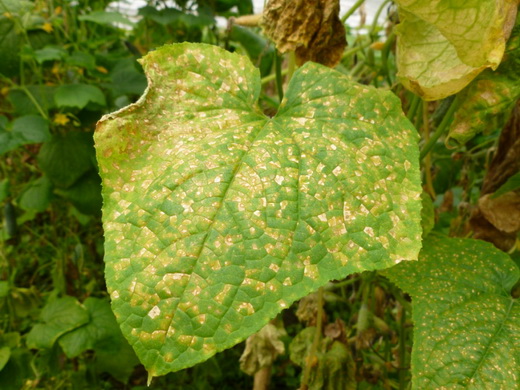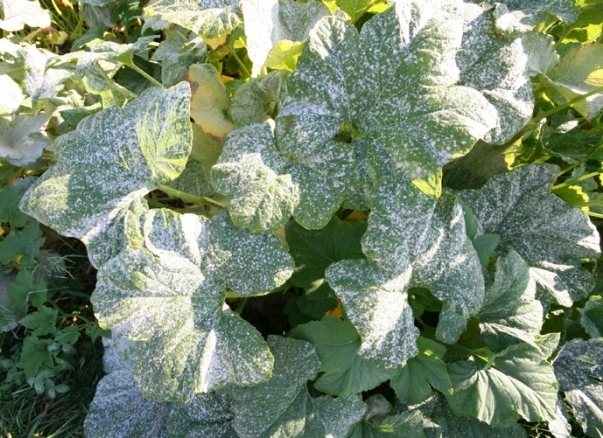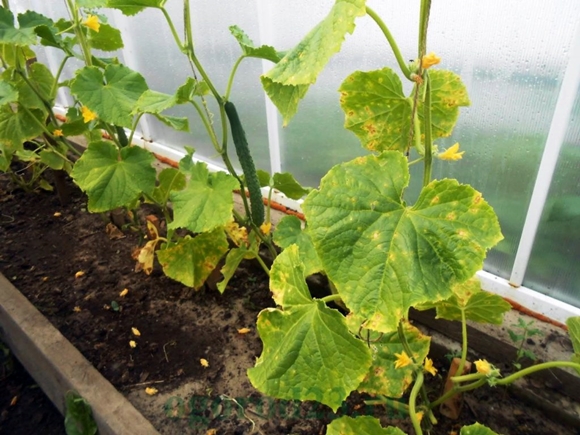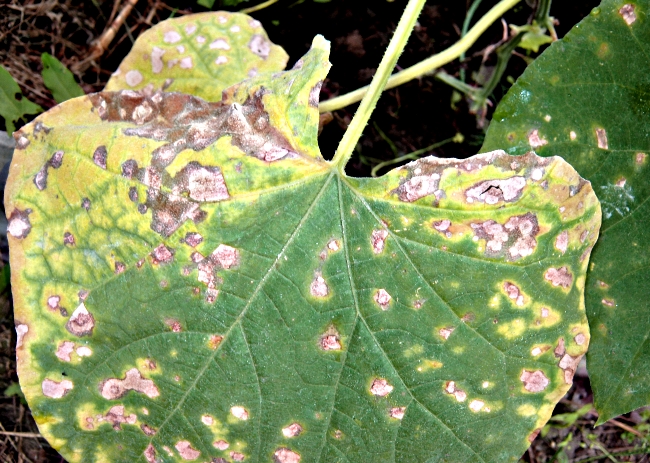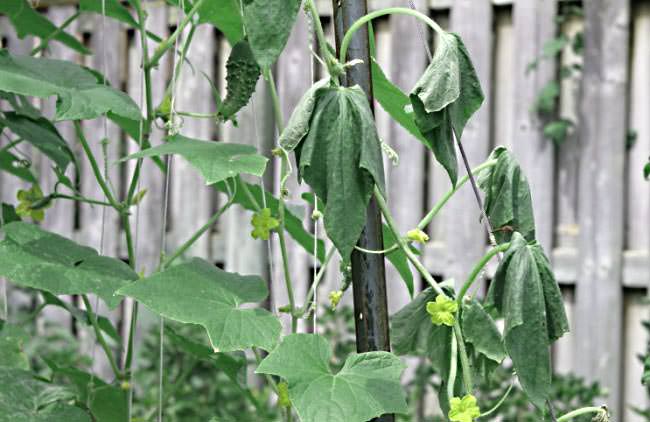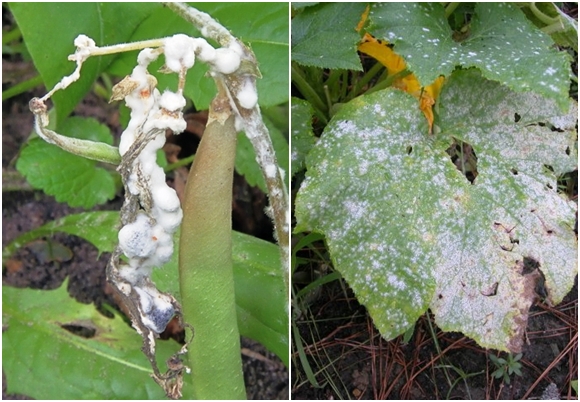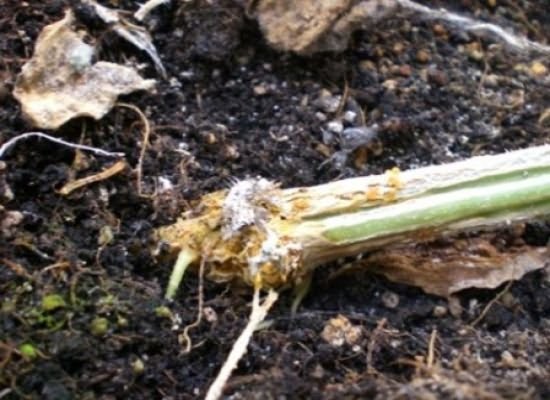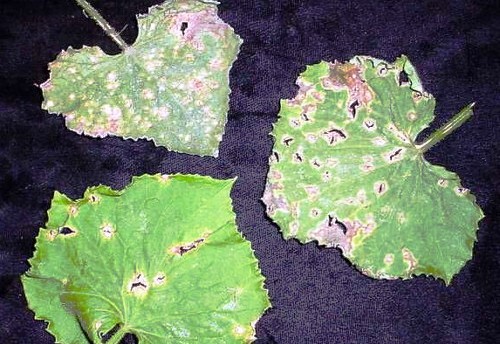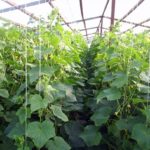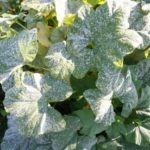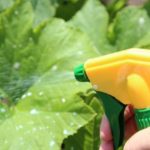When growing cucumbers, many vegetable growers face a considerable number of problems, since these plants often suffer from various diseases. At the same time, viral diseases of cucumbers can appear even if they are grown in a greenhouse.
- Causes of diseases
- Powdery mildew
- Signs
- Causes
- Prevention
- Treatment
- Downy mildew
- Signs
- Causes
- Prevention
- Treatment
- Cladosporiosis
- Signs
- Causes
- Prevention
- Treatment
- Fusarium wilt
- Signs
- Causes
- Prevention
- Treatment
- Gray rot
- Signs
- Causes
- Prevention
- Treatment
- Root rot
- Signs
- Causes
- Prevention
- Treatment
- Anthracnose
- Signs
- Causes
- Prevention
- Treatment
- Conclusion
Quite often this happens due to the use of small greenhouses or violations of growing rules. To restore the health of the bushes, it is necessary to study in advance the diseases of cucumbers in the greenhouse and their treatment.
Causes of diseases
Diseases of cucumbers in a greenhouse can appear due to certain predisposing factors or conditions. There are several reasons why bushes begin to hurt:
- Air humidity level. When growing crops, it is necessary to carefully monitor air humidity. If it is too high, then ideal conditions will be created for the development of the disease in greenhouse cucumbers. If the air is too humid, the fruits, stems and root systems of plants can be damaged.
- Failure to comply with agrotechnical requirements during cultivation.
- Incorrect crop rotation. Often, inexperienced gardeners plant cucumbers in the same place for several years. Also, violations of crop rotation include planting bushes in areas where plants that were incompatible with cucumbers previously grew.
- Bad light. Sometimes greenhouses are installed in places with insufficient sunlight. For growing, it is recommended to choose areas that are well lit by the sun.
- Lack of useful microelements and complete depletion of the soil. To ensure that the soil always contains a sufficient amount of nutrients, it is necessary to periodically feed it. This feeding consists of vitamins, minerals and other useful elements that young bushes need.
- Incorrect watering. You need to water the bushes very carefully so that water does not get on the leaves.
- Late detection of diseased seedlings. It is recommended to regularly inspect the bushes to check for diseases and pests of cucumbers.If the disease is not detected in time at the initial stage of development, then it will eventually spread to the rest of the bushes.
- Improper ventilation. The greenhouse must be ventilated periodically. However, this must be done carefully so that there is no strong draft.
- Contaminated greenhouse. The greenhouse should be periodically cleared of fallen cucumber leaves, as various diseases develop in them.
Powdery mildew
One of the most common diseases affecting cucumbers is powdery mildew.
Signs
When this disease occurs, spots appear on the leaves of cucumbers in the greenhouse. Over time, they can spread to the stems. The spots are colored grayish or white and therefore in appearance they resemble scattered flour.
If you do not get rid of powdery mildew in a timely manner, the spots will spread throughout the plant. This will lead to the cessation of fruit appearance, drying of the leaves and the death of the plant.
Causes
The main reason why this disease appears is incorrect temperature conditions. The disease appears at low temperatures during cool and cloudy weather. If the air temperature is increased to 25-30 degrees, the spores will be destroyed. The disease can also appear if fertilizers that contain a lot of nitrogen are often added to the soil.
Prevention
In order not to waste time on treating cucumber leaf disease in the future, you need to figure out how to protect cucumbers from it. For prevention it is necessary:
- water the bushes with warm water several times a week;
- monitor the beds with cucumbers - periodically weed them, remove weeds and fallen dry leaves;
- cover the bushes with film or close the greenhouse to raise the temperature in it;
- grow only those varieties that are resistant to powdery mildew.
Treatment
Some people don't know how to deal with this disease. Powdery mildew can also be cured using folk remedies. To do this, you need to spray the bushes with a mullein solution. To make a solution, one kilogram of the substance is poured into 3-5 liters of water and infused for 5 days. Then the infusion is passed through cheesecloth and again filled with 5 liters of clean water.
If you don’t have mullein, you can use sour milk. To do this, it is mixed with boiled water in a one to one ratio. You need to spray cucumbers with this solution no more than once a week.
You can also get rid of powdery mildew using a soda solution. During its preparation, 100 g of the substance is mixed with 100 g of laundry soap and a liter of water. The prepared product must be used every week.
Downy mildew
The disease can appear on bushes of any age. In this case, not only plants growing in greenhouses suffer, but also in open ground.
Signs
Signs of the disease appear almost immediately after its appearance. Spots appear on cucumbers in the greenhouse, their leaves turn light yellow. After a few days, they begin to change their color and acquire a brown tint. It is necessary to treat the disease, since its further development will lead to the drying out of all the leaves and the death of the cucumber bush.
Causes
Downy mildew occurs due to fungi, which are often found in greenhouses. They develop due to too humid air. Fungus can also appear if you frequently water the bushes with cold water.
Prevention
To protect cucumbers in a greenhouse from diseases and peronosporosis, you must adhere to certain rules:
- do not water young plant bushes with very cold water;
- do not thicken the plantings and plant seedlings less frequently;
- timely harvesting of fruits;
- disinfect seeds before planting them in the ground;
- remove plant remains from the site, as spores of cucumber diseases can develop in them.
Treatment
Used to treat peronosporosis folk remedies for cucumber diseases. An effective remedy that will help get rid of peronosporosis is whey. You need to treat the bushes with liquid several times a week.
Fungal diseases do not tolerate copper well, so you can get rid of peronosporosis using Bordeaux mixture. To prepare it yourself, you should mix 100 grams of lime and copper sulfate with a soap solution. It is recommended to use Bordeaux mixture once a week until the plants are completely healed.
Cladosporiosis
Brown spot is quite common in mature bushes and affects their leaves and fruits.
Signs
Cladosporiosis is a rather dangerous disease that can spread to all bushes within one week. The first signs of the disease begin to appear on the stems and leaves. They become covered with brown spots, which eventually spread to the fruits. Grown cucumbers affected by the disease should not be eaten, so they should be collected and discarded immediately.
To become more familiar with the signs of the disease, you can examine photos of leaves that are affected by cladosporiosis.
Causes
The disease occurs and actively develops with serious temperature changes. Also, cladosporiosis can appear after watering the bushes with ice water.The disease begins to appear at the final stage of the growing season, when the night temperature is much lower than the day temperature.
Another common cause of brown spot is vegetable debris. Over time, they accumulate a huge amount of fungal spores, which are very dangerous for cucumbers.
Prevention
Many people do not know what to do to protect bushes from cladosporiosis infection. To prevent the disease it is necessary:
- plant cucumber seedlings in well-lit greenhouses;
- water the bushes only with heated and infused water;
- regularly clean the beds of accumulated plant debris;
- water the cucumbers at the root so that the liquid does not fall on their leaves;
- Ventilate the greenhouse several times a week.
Treatment
When the first signs of cladosporiosis are detected, it is necessary to stop watering the plants. If the temperature in the greenhouse is below 20 degrees Celsius, it must be increased immediately. The fight against cucumber diseases and cladosporiosis involves treating the plant bushes with Bordeaux mixture or preparations that contain copper. You can also use ash and lime with them.
Bushes should be treated with special sprayers, and not with an ordinary watering can.
Fusarium wilt
Not all varieties cucumbers are resistant to fusarium, so many vegetable growers often encounter this disease.
Signs
A plant can become infected with fusarium at an early stage of its development, but the first signs will begin to appear only during fruit ripening or flowering. First, the leaves located in the lower part of the bush will begin to gradually fade. Over time, the wilting will spread to the upper leaves, which immediately turn yellow and change their shape.
Fusarium is confused with verticellosis because these diseases have similar symptoms. To distinguish them, you need to cut off one bush and carefully examine the vessels of the stem. If cucumbers are sick with fusarium, they will be dark brown in color. With verticellosis, the vessels are much lighter.
Causes
To infect cucumbers with fusarium, a special pathogen is required. Fungi may be present on the surface of the equipment or located in the ground. They are also often present in seedling substrates and collected seeds. There are several factors that cause Fusarium wilt:
- insufficient amount of light in the greenhouse;
- seedlings are planted too close to each other;
- the soil contains a large amount of fertilizers containing nitrogen or chlorine;
- The greenhouse is installed near industrial production.
Prevention
To prevent fusarium disease, you need to soak cucumber seeds before planting. This is done using a strong solution of potassium permanganate, heated to 70 degrees. Before planting, the seed is placed in this solution for 2-4 hours for disinfection.
Treatment
Before spraying the bushes, you should figure out how to do it. Processing and treatment of cucumbers must be carried out with special means. The disease can be treated with biological drugs. An effective remedy against fusarium is Trichodermin.
It can be added to the substrate for seedlings. About 2 g of the drug is consumed for each seedling bush. It can also be added to the soil at the rate of 1 kg per square meter of land.
Besides this, get rid of this diseases of cucumber seedlings possible using Pseudobacterin-2. To prepare the mixture, 100 ml of the drug is mixed with a liter of water.
Gray rot
The disease spreads by contact and air during harvesting or when caring for bushes.
Signs
Gray rot is manifested by the spread of brown spots on cucumber leaves. With high humidity, mold appears on cucumbers with fluffy gray spores, which are carried to other bushes by drafts.
Causes
The disease appears and begins to actively develop only under certain conditions. The most suitable environment for the appearance of gray mold is low temperature and waterlogging. Therefore, it is recommended to regularly monitor the humidity and temperature in the greenhouse.
Prevention
To prevent the appearance of gray rot and protect cucumbers from diseases, you need to:
- properly care for the bushes and regularly spray them with special protective preparations;
- plant cucumbers at a distance of at least 80 cm from each other;
- be sure to spray the beds and greenhouse after harvesting;
- observe crop rotation.
Treatment
When the first symptoms of gray rot appear, it is recommended to stop watering the plants for 2-5 days. You should also ventilate the greenhouse and get rid of all affected leaves. To treat cucumber bushes, you can use ash or copper-chalk powder.
Root rot
Cucumbers can become infected with this disease at any stage of their development.
Signs
First, the disease spreads to the root system of cucumbers. The roots turn brown and begin to dry out. If treatment is not promptly done, they will begin to die. The disease then affects the root collar and stem. They also begin to change color and fade.
Causes
Root rot occurs when there are strong temperature changes.This disease of cucumbers can also appear due to regular watering of bushes with cold water or planting seedlings too deep in the ground. It is recommended to immediately get rid of the remains of plants that have been infected with root rot, as they also spread the disease.
Prevention
Protection of greenhouse cucumbers from diseases and pests is as follows:
- water the cucumber seedlings with heated water;
- periodically adjust the temperature in the greenhouse to avoid serious changes;
- Do not plant cucumbers in areas where there was root rot.
Treatment
If signs of root rot have been identified, you must:
- remove soil from bushes;
- fertilize the roots of the plant with manure and special disinfectants (you can prepare a solution of 5 tablespoons of ash mixed with a liter of water and a teaspoon of copper sulfate);
- sprinkle the stems of the bushes with chalk or ash;
- dig up infected seedlings and burn.
Anthracnose
A fairly common disease that appears when growing cucumbers in greenhouses.
Signs
During anthracnose, brown spots appear on the plant. Within a few days, the leaves will begin to turn yellow and wet sores will appear on the cucumbers. Therefore, recognizing this disease is not so difficult.
Causes
Most often, a plant becomes infected with copperhead due to diseased seeds that were previously collected from the bushes. The disease can also appear due to a fungus located in plant debris or the top layer of soil. In addition, anthracnose can spread quickly due to temperature changes and frequent watering with ice water.
Prevention
To prevent the disease, it is necessary not to forget about proper crop rotation, so you need to plant cucumbers in their original place only after 3-4 years. You should also periodically clean the greenhouse of plant debris that accumulates during the cultivation of cucumbers.
Treatment
Before processing cucumbers, you need to figure out what to use for this. To get rid of anthracnose, you need to spray them weekly with a weak Bordeaux mixture. Instead, you can use a 0.5% solution of copper sulfate or a mixture of coal and lime. Treatment of cucumbers against diseases should be carried out in the evening after watering.
Conclusion
There are quite a few different diseases of cucumbers. To prevent their occurrence, you need to familiarize yourself with how to prevent diseases of cucumbers in a greenhouse.

